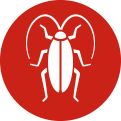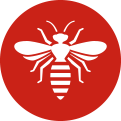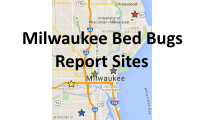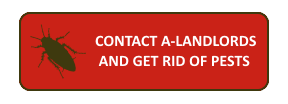Bed Bug Exterminator in Milwaukee

Bed Bug Exterminators Serving Metro Milwaukee Area
Homeowners and businesses around Milwaukee often attempt to exterminate bed bug infestations through DIY methods they found on the internet. These efforts fail 99% of the time, and in some cases, can make your bed bug infestation worse. When you have bed bugs, hiring professional bed bug exterminators are the only reliable way to eliminate bed bug infestations and keep them from coming back.
Milwaukee Bed Bugs are Persistent
Bed bugs are highly resistant to commercial products used in their extermination, and because of this, a combination of pest control methods must be used, including pesticide applications and manual removal.
The bed bug exterminators at A-Landlords Pest Management in Milwaukee, WI are experts in identifying and removing bed bug infestations.
In fact, bed bugs are our specialty.
Bed bugs have extraordinarily small bodies colored with a brown camouflage pattern. They lay eggs everywhere, and once an infestation has started, it is hard to resolve without the help of professionals.
- Bed bugs give off a musty odor
- Bite marks, with a burning sensation, generally in a straight line
- Brown and black spots on infected surfaces
- Blood stains on mattresses in bedding from crushed bugs
Our bed bug exterminators in Milwaukee, WI, are experts in identifying bed bugs and the problem areas in your home. Contact us today for professional bed bug removal.
Wis. Stat. 704.07(3)(a)
If the premises are damaged, including by an infestation of insects or other pests, due to the acts or inaction of the tenant, the landlord may elect to allow the tenant to remediate or repair the damage and restore the appearance of the premises by redecorating. However, the landlord may elect to undertake the remediation, repair, or redecoration, and in such case the tenant must reimburse the landlord for the reasonable cost thereof.
The responsibility of the repairs and cleanup of any pest problem brought on by the tenant is solely the tenant's. Prevent damage from spreading and having those costs fall on you by calling A-Landlords today to have your bed bug problem taken care of.
If you choose to pursue litigation against your landlord, you need to know the burden of proof is on you, and it's tough to prove the bedbugs were not a problem initiated by you, the tenant. If you can prove the burden is on the landlord, call A-Landlords today to get your bed bug problem taken care of at the expense of your landlord.
There are several myths surrounding bed bug infestations, including:
- Once a piece of furniture is infested, it must be thrown out.
If your bed bug infestation is handled properly, your furniture will be eradicated of the pest within.
- Bed bugs only affect beds.
Bed bugs also do not infest beds alone; they will infest virtually anything they can hide on or in and find a food source from (you). Bed bugs will gladly hitch a ride on your sweater to your car, your office, friend’s house, or child’s school, dropping off and infesting every area they can along the way. Learn more about bed bug causes and where to find them.
- Bed bugs spread diseases.
According to CDC researchers, bed bugs DO NOT spread diseases. They only cause irritation through itchy bites and loss of sleep. An excessive number of bites or picking at bites can lead to skin infection, though.
Bed bugs are generally active at night and feed on blood. Without blood, they are not able to grow or reproduce, but they can go as long as a year without feeding, so leaving your home for a week won’t do the trick. Calling in professional bed bug exterminators is your best option when it comes to handling a bed bug infestation.
- Mattresses
- Bedding (sheets, comforters, etc.)
- Clothing
- Furniture
- Other soft places with convoluted surfaces

At one point in history, bed bugs were considered almost completed eradicated from North America. Due to an increase in people traveling and a decrease in public knowledge about bed bugs, they have made a surging comeback, infesting homes and business across the nation, including Milwaukee, WI. Another reason for the bed bugs’ comeback is their resistance to many commercial pest control methods; proving the importance of getting professional help with your bed bug infestation, rather than trying to eliminate the problem yourself.
- They always stay around where people sleep.
- A bed bug can travel up to 100 feet overnight.
- Bed bugs can go several months without feeding.
- They hide in bed frames, mattress seams, headboards, long carpet, and other dark areas during the day.
- Bed bugs are typically nocturnal, but they will adapt to your sleep schedule if necessary.
- A typical bed bug lays up to 7 eggs per week and can lay over 500 eggs in its lifetime.
You should always be careful when transferring infested clothing, bedding, or anything else bed bugs might be living on or in. They can easily fall off of the infected surface and start populating a new area. This is why we don't recommend moving infested furnishings out of your home. Bedbugs can easily fall off while you're moving a sofa out to the curb, and then you have bedbugs infesting another room of your house.
Best advice: Keep your home, business, friends' homes, and family’s home safe from bed bugs by having our expert Milwaukee bed bug exterminators eradicate your bed bug infestation.
 Get Rid of Pests Now!
Get Rid of Pests Now!
Contact our Milwaukee bed bug exterminators when you need cost-effective help ridding your home of a bed bug infestation.
Bed Bug Exterminators For All Milwaukee Infestations
Homeowners and businesses in Milwaukee, Wauwatosa and West Allis attempt to rid themselves of bed bug infestations and these efforts go unnoticed by bed bugs, or, in some cases, can make your bed bug infestation worse, unfortunately. When you have bed bugs, you need professional bed bug pest control to eliminate your bed bug infestation entirely.
Remember: what doesn't kill them only makes them stronger.
Bed bugs are highly resistant to commercial products used in their extermination, and because of this, a combination of pest control methods must be used, including pesticide applications and manual removal.
The Enemy: Bed Bugs
The bed bug exterminators at A-Landlords Pest Management in Milwaukee, WI are experts in identifying and removing bed bug infestations.
In fact, bed bugs are our specialty.
Bed bugs have extraordinarily small bodies colored with a brown camouflage pattern, they lay eggs everywhere, and once an infestation has started, it is hard to resolve without the help of professionals.
Identifying the Presence of a Bed Bug Infestation
- Bed bugs give off a musty odor
- Bite marks, with a burning sensation, generally in a straight line
- Brown and black spots on infected surfaces
- Blood stains on mattresses in bedding from crushed bugs
How to Treat Bed Bug Bites
Why Take Care of Bed Bugs ASAP? Wisconsin's Bed Bug Ordinance
Wis. Stat. 704.07(3)(a)
"If the premises are damaged, including by an infestation of insects or other pests, due to the acts or inaction of the tenant, the landlord may elect to allow the tenant to remediate or repair the damage and restore the appearance of the premises by redecorating. However, the landlord may elect to undertake the remediation, repair, or redecoration, and in such case the tenant must reimburse the landlord for the reasonable cost thereof."
The responsibility of the repairs and cleanup of any pest problem brought on by the tenant is solely the tenant's/s'. Prevent damage from spreading and having those costs fall on you by calling A-Landlords today to have your bed bug problem taken care of.
If you choose to pursue litigation against your landlord, you need to know the burden of proof is on you, and it's tough to prove the bedbugs were no a problem initiated by you, the tenant. If you can prove the burden is on the landlord, call A-Landlords today to get your bed bug problem taken care of at the expense of your landlord.
Bed Bug Infestations and Resurgence
There are several myths surrounding bed bug infestations, including:
- Once a piece of furniture is infested, it must be thrown out.
If your bed bug infestation is handled properly, your furniture will be eradicated of the pest within.
- Bed bugs only affect beds.
Bed bugs also do not infest beds alone, they will infest virtually anything they can hide on or in and find a food source from (you). Bed bugs will gladly hitch a ride on your sweater to your car, your office, friend’s house, or child’s school, dropping off and infesting every area they can along the way. Learn more about bed bug causes and where to find them.
- Bed bugs spread diseases.
According to CDC researchers, bed bugs DO NOT spread diseases. They only cause irritation through itchy bites and loss of sleep. An excessive number of bites or picking at bites can lead to skin infection, though.
Bed bugs are generally active at night and feed on blood. Without blood, they are not able to grow or reproduce, but they can go as long as a year without feeding, so leaving your home for a week won’t do the trick. Calling in professional bed bug exterminators is your best option when it comes to handling a bed bug infestation.
Where Bed Bugs are Commonly Found:
- Mattresses
- Bedding (sheets, comforters, etc.)
- Clothing
- Furniture
- Other soft places with convoluted surfaces

At one point in history, bed bugs were considered almost completed eradicated from North America. Due to an increase in people traveling and a lack of public knowledge about bed bugs, they have made a surging comeback, infesting homes and business across the nation, including Milwaukee, WI. Another reason for the bed bugs’ comeback is their resistance to many commercial pest control methods; proving the importance of getting professional help with your bed bug infestation, rather than trying to eliminate the problem yourself.
Learn More About Bed Bug Infestations:
- Bed Bug Infestation Site Reports
- DIY Bed Bug Remedy Fails
- Milwaukee Bed Bug Exterminators Provide Exceptional Pest Control Services
- Milwaukee Pest Management Experts Deliver Valuable Bed Bug Knowledge
- Milwaukee Bed Bug Infestations
- Milwaukee Exterminator Keeping Your Home and Business Safe from Unwanted Pests
- Bed Bug Mattress Covers
- Bed Bug Traveling Tips
Bed Bug Solutions
You should always be careful when transferring infested clothing, bedding, or anything else bed bugs might be living on or in. They can easily fall off of the infected surface and start populating a new area. This is why we don't recommend moving infested furnishings out of your home. Bedbugs can easily fall off while you're moving a sofa out to the curb, and then you have bedbugs infesting another room of your house.
Best advice: Keep your home, business, friends' homes, and family’s home safe from bed bugs by having our expert Milwaukee bed bug exterminators eradicate your bed bug infestation.









 Bed Bug
Bed Bug Ant
Ant Roach
Roach Wasp
Wasp Spider
Spider Rodent
Rodent



